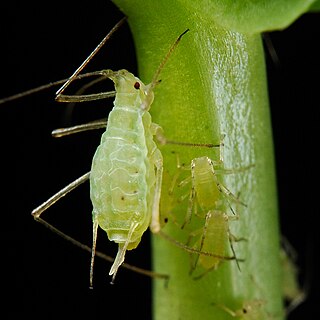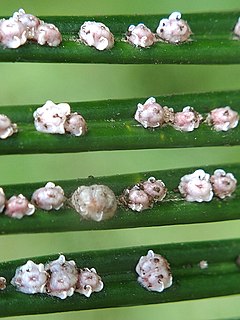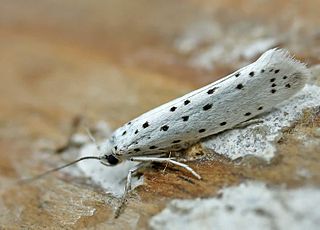 W
WAcleris variegana, the garden rose tortricid moth or fruit tortricid, is a moth of the family Tortricidae. It has a Palearctic distribution. The moth flies from July to September mainly at night and is attracted to bright lights. The larvae feed on various trees and shrubs including rose and apple.
 W
WAcyrthosiphon pisum, commonly known as the pea aphid, is a sap-sucking insect in the family Aphididae. It feeds on several species of legumes worldwide, including forage crops, such as pea, clover, alfalfa, and broad bean, and ranks among the aphid species of major agronomical importance. The pea aphid is a model organism for biological study whose genome has been sequenced and annotated.
 W
WAlsophila aescularia, the March moth, is a species of moth of the family Geometridae. It is found throughout Europe and is a pest of fruit trees.
 W
WAphids are small sap-sucking insects and members of the superfamily Aphidoidea. Common names include greenfly and blackfly, although individuals within a species can vary widely in color. The group includes the fluffy white woolly aphids. A typical life cycle involves flightless females giving living birth to female nymphs—who may also be already pregnant, an adaptation scientists call telescopic development—without the involvement of males. Maturing rapidly, females breed profusely so that the number of these insects multiplies quickly. Winged females may develop later in the season, allowing the insects to colonize new plants. In temperate regions, a phase of sexual reproduction occurs in the autumn, with the insects often overwintering as eggs.
 W
WThe bird-cherry ermine is a species of moth in the family Yponomeutidae, the ermine moths. The wingspan of the moth ranges from 16 to 25 mm. The insect was first described in 1758 by the Swedish naturalist Carl Linnaeus who gave it the name Phalaena evonymella; it was later transferred to the genus Yponomeuta, becoming Yponomeuta evonymella. The moth can be found in the whole of Europe and the northern and eastern part of Asia.
 W
WContarinia quinquenotata is a small midge which infests the flower buds of Hemerocallis species, cultivars, and mature unnamed seedlings, causing the buds to remain closed and rot. It is a pest within the horticultural trade in several parts of the world. It is known by the common names of daylily gall midge and hemerocallis gall midge.
 W
WThe grapeleaf skeletonizer is a moth in the family Zygaenidae. It is widespread in the eastern half of the United States, and commonly noticed defoliating grapes, especially of the Virginia creeper. The western grapeleaf skeletonizer is very similar to and slightly larger than H. americana, but their distributions are different.
 W
WThe gypsy moth was introduced in 1868 into the United States by Étienne Léopold Trouvelot, a French scientist living in Medford, Massachusetts. Because native silk-spinning caterpillars were susceptible to disease, Trouvelot imported the species in order to breed a more resistant hybrid species. Some of the moths escaped, found suitable habitat, and began breeding. The gypsy moth is now a major pest of hardwood trees in the Eastern United States.
 W
WHeteronychus arator is a species of beetle in the subfamily Dynastinae. It is commonly called African black beetle or black lawn beetle. It is native to Africa and it is an introduced species in Australia and on the North Island of New Zealand.
 W
WThe iris sawfly is a species of sawfly in the family Tenthredinidae. Native to Europe, the larvae — more often noticed than the adults — can occur in large numbers causing damage to garden plants such as the yellow iris or flag, Iris pseudacorus.
 W
WThe Japanese beetle is a species of scarab beetle. The adult measures 15 mm (0.6 in) in length and 10 mm (0.4 in) in width, has iridescent copper-colored elytra and a green thorax and head. It is not very destructive in Japan, where it is controlled by natural predators, but in North America, it is a noted pest of about 300 species of plants including rose bushes, grapes, hops, canna, crape myrtles, birch trees, linden trees, and others.
 W
WMacrodactylus subspinosus is a North American beetle of the family Scarabaeidae. The members of this genus are known as "rose chafers", not to be confused with the European "rose chafer", Cetonia aurata. M. subspinosus occurs from Eastern Canada to Colorado and is considered a pest of many crops and flowers. It is given its common name of rose chafer because it eats the leaves of roses, although it also feeds on many other plants.
 W
WMealybugs are insects in the family Pseudococcidae, unarmored scale insects found in moist, warm habitats. Many species are considered pests by some humans as they feed on plant juices of greenhouse plants, house plants and subtropical trees and also act as a vector for several plant diseases. Some ants, however live in symbiotic relationships with them.
 W
WThe mullein moth,, is a noctuid moth with a Palearctic distribution.
 W
WPaysandisia archon is a moth of the family Castniidae. It is native to Uruguay and central Argentina and has been accidentally introduced to Europe, where it is spreading rapidly. It is considered the only member of the genus Paysandisia.
 W
WPulvinaria regalis is a species of scale insect in the family Coccidae. Although it is commonly known as the horse chestnut scale, it affects other trees besides horse chestnuts as well as many species of woody shrubs. Adults are normally all female and produce eggs by parthenogenesis. The insects are thought to have originated in Asia but arrived in Europe in the second half of the twentieth century.
 W
WRhopalosiphum rufiabdominale, the rice root aphid or red rice root aphid, is a sap-sucking insect pest with a wide host range and a global distribution. As a member of the superfamily Aphidoidea, it is one of 16 species of the genus Rhopalosiphum. Adults and nymphs are soft-bodied and usually dark green with brown, red, or yellow tones. Like all aphids, reproduction is sexual and asexual, depending on the environmental conditions and host plant. Rice root aphids cause injury to external plant parts, namely the roots or stem, by feeding on plant sap and vector several important plant viruses. The hosts of this pest extend across multiple plant families with most belonging to Rosaceae, Poaceae, and Solanaceae. R. rufiabdominale is universally associated with Prunus species but also infests various field crops, greenhouse vegetables, cannabis, and other ornamental plants. While this aphid originates from east Asia, it spans nearly every continent. Dispersal is particularly widespread across the United States, India, and Australia, with crop damage documented in multiple instances, although economic losses are primarily associated with Japanese rice crops. Nonetheless, it remains a pest of serious concern due to its high mobility, discrete habitat, and adaptive plasticity, giving it the rightful reputation as a successful invader.
 W
WSawflies are the insects of the suborder Symphyta within the order Hymenoptera alongside ants, bees and wasps. The common name comes from the saw-like appearance of the ovipositor, which the females use to cut into the plants where they lay their eggs. The name is associated especially with the Tenthredinoidea, by far the largest superfamily in the suborder, with about 7,000 known species; in the entire suborder, there are 8,000 described species in more than 800 genera. Symphyta is paraphyletic, consisting of several basal groups within the order Hymenoptera, each one rooted inside the previous group, ending with the Apocrita which are not sawflies.
 W
WScale insects are small insects of the order Hemiptera, suborder Sternorrhyncha. Of dramatically variable appearance and extreme sexual dimorphism, they comprise the superfamily Coccoidea. Adult females typically have soft bodies and no limbs, and are concealed underneath domed scales, extruding quantities of wax for protection. Some species are hermaphroditic, with a combined ovotestis instead of separate ovaries and testes. Males, in the species where they occur, have legs and sometimes wings, and resemble small flies. Scale insects are herbivores, piercing plant tissues with their mouthparts and remaining in one place, feeding on sap. The excess fluid they imbibe is secreted as honeydew on which sooty mold tends to grow. The insects often have a mutualistic relationship with ants, which feed on the honeydew and protect them from predators. There are about 8,000 described species.
 W
WThe scarlet lily beetle, red lily beetle, or lily leaf beetle, is a leaf beetle that eats the leaves, stem, buds, and flowers, of lilies, fritillaries and other members of the family Liliaceae. It lays its eggs most often on Lilium and Fritillaria species. In the absence of Lilium and Fritillaria species, there are fewer eggs laid and the survival rate of eggs and larvae is reduced. It is now a pest in most temperate climates where lilies are cultivated.
 W
WThe Sciaridae are a family of flies, commonly known as dark-winged fungus gnats. Commonly found in moist environments, they are known to be a pest of mushroom farms and are commonly found in household plant pots. This is one of the least studied of the large Diptera families, probably due to the small size of these insects and the difficulty in specific identification.
 W
WSpodoptera cilium, known variously as dark mottled willow, lawn caterpillar and grasslawn armyworm, is a noctuid moth found throughout much of sub-Saharan Africa and western, southern, and south-east Asia and several countries in southern and eastern Europe. It is a migrant to northern Europe and has been recorded at least nine times in the United Kingdom.
 W
WThe andromeda lace bug is a pest insect on plants of the genus Pieris, especially Pieris japonica, the Japanese andromeda. It originated in Japan with its host plant but has since been introduced to other areas of the globe. At least one Pieris species, Pieris floribunda, is resistant to the bug.
 W
WSynanthedon scitula, the dogwood borer or pecan borer, is a moth that is a pest of many plants including the dogwood and pecan. It is notorious due to the severity of damage it can cause and its widespread geographical distribution.
 W
WTenthredo scrophulariae, the figwort sawfly is a species of the family Tenthredinidae, subfamily Tenthredininae.
 W
WBlack vine weevil is an insect native to Europe but common in North America as well. It is a pest of many garden plants.
 W
WYponomeuta malinellus, the apple ermine, is a moth of the family Yponomeutidae. It is native to Europe and Asia, and it has spread to North America.
 W
WYponomeuta padella is a lepidopteran from the family Yponomeutidae, the ermine moths.It is also known as the cherry ermine